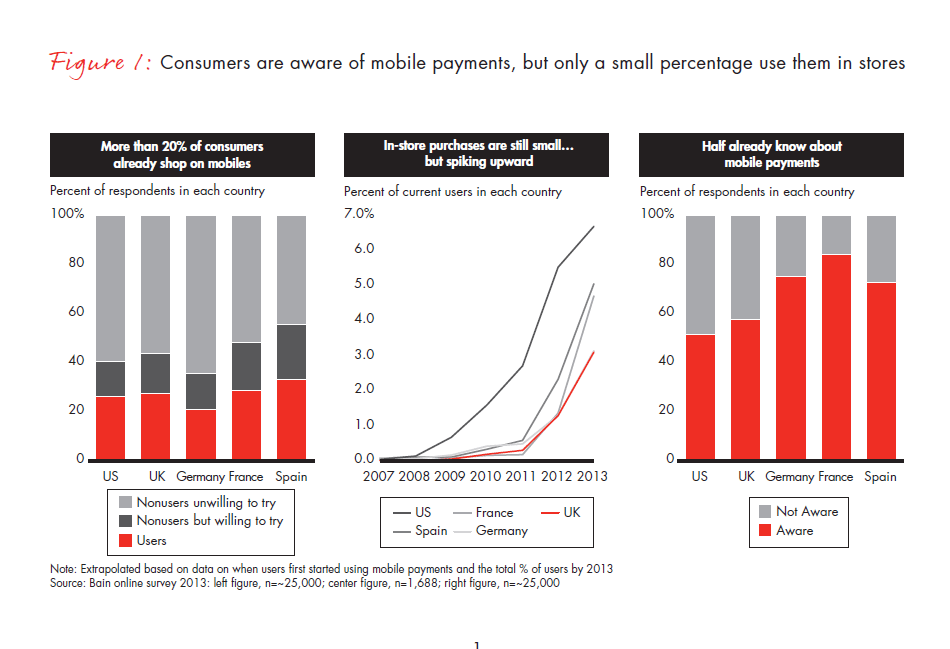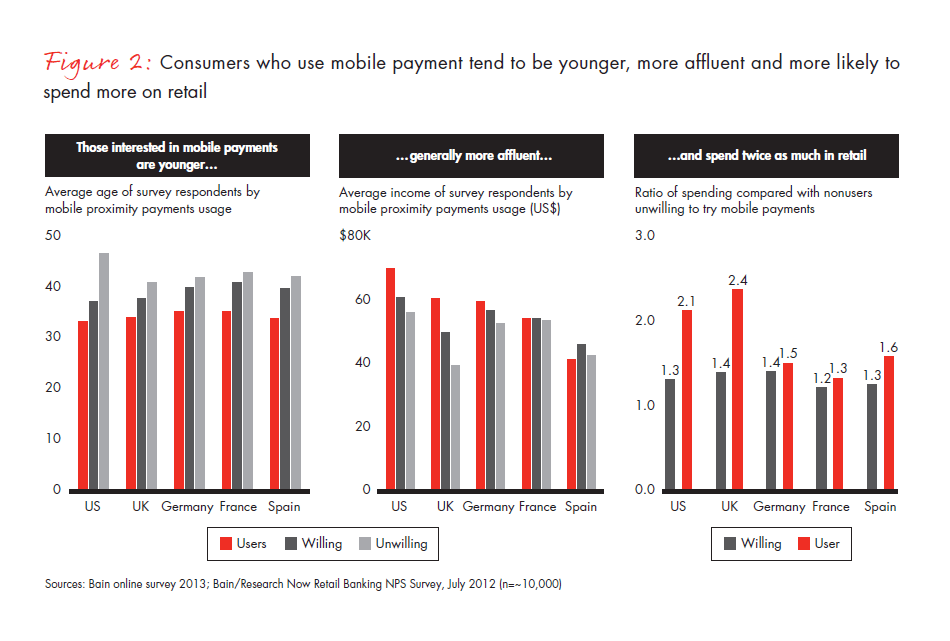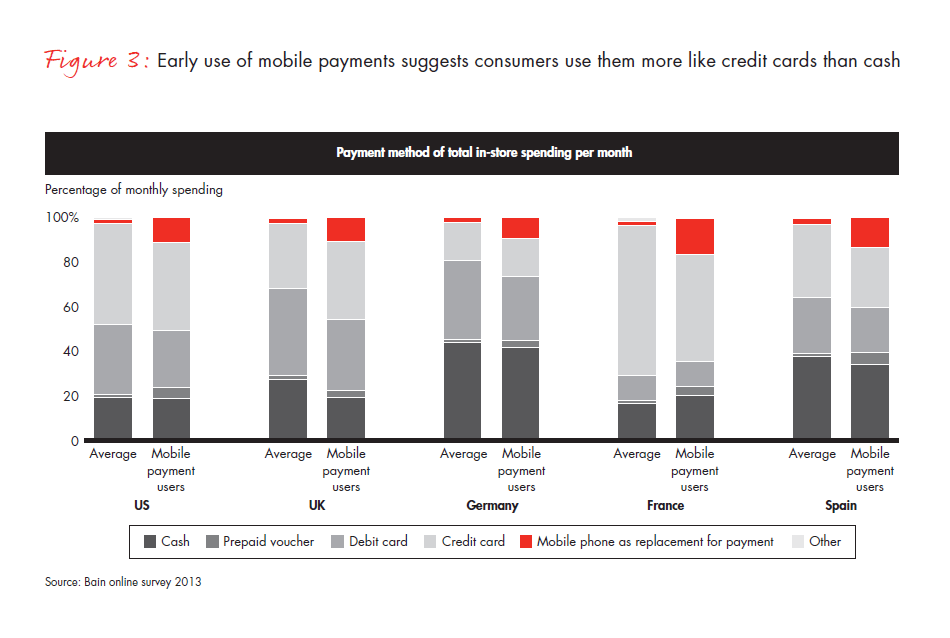Brief
For at least a decade, there’s been something mirage-like about mobile payments: They have always seemed just over the horizon and receding as we think we’re getting closer.
We think that’s about to change, given an unprecedented rise in the momentum among consumers and investors—providing that the players can overcome the technical and behavioral hurdles that remain. Our recent survey of approximately 25,000 consumers in the US and major Western European markets found that many are already shopping on their mobiles, some are using them for payments and many more expect to do so over the next few years (see Figure 1).

Start-ups have produced much innovation, but we also see sustained and growing investment from retailers, banks and mobile operators, as well as from top technology players, including Amazon, Apple, Facebook, Google, Microsoft and Samsung. Small pilots are giving way to full national rollouts, as in Spain, where the initial pilot by La Caixa, Telefonica and Visa Europe in the city of Sitges has expanded into a national rollout planned for February 2014, and in the US, where Isis relies on its partnerships with telecom operators to market aggressively to customers when they buy a new handset.
In-store mobile payments are relatively small today, with only 3% to 7% of consumers using their phones to buy coffee, books or other physical goods in stores. But that number is growing fast: Nearly twice as many consumers started using mobile payments in 2013 as they did in 2012. Another 16% to 27%, depending on the country, say they are willing to try.
Will consumers change how they buy?
Notwithstanding this small but significant show of enthusiasm, payment habits remain difficult to change. Most consumers believe the way they pay for things today is good enough—although when nudged they admit to minor annoyances like the many receipts they are left with or the number of steps involved in a card purchase. History suggests they will adopt new forms of financial technology when the benefits become clear, as they did with online and mobile banking. Despite massive investments and hype, a clearer customer benefit remains the missing piece needed to trigger mass adoption of mobile payments.
Our work looked at how different segments of customers think about mobile payments. For about a quarter of consumers who said they would consider using their mobiles for purchases, the novelty is reason enough to try it. Another segment (13%) is attracted by financial rewards such as discounts, location-based coupons and better loyalty offers. Many in this group are willing to trade their personal data in exchange for better, more relevant offers. Daily deals (like those from Groupon) or mobile coupons (such as those from UK mobile operator consortium Weve) are among the forms taking shape.
The largest segment, representing about two-thirds of consumers, want more convenience from mobile payments—whether it’s a faster checkout, the ability to see a balance or other benefits. LifeLock’s Lemon app bases its offer on simplifying how users carry and store their many cards and receipts. McDonald’s is testing an app that lets customers order and pay before they reach the store, and pick up their order inside or in the drive-through. And some of the most forward-thinking applications integrate customers’ payment activities with money management and budgeting software, to allow real-time financial management without entering details from receipts.
Regardless of the specific value proposition, successful mobile payment solutions will have to address consumers’ biggest concerns: security, privacy and convenience. In some markets, speed, ease of use and the ability to choose funding sources are also concerns. In France and Spain, customers like the security of two-step verification (for example, an ID code and a physical chip) because they’re already comfortable with that method for credit card purchases. Addressing these concerns as they develop, deploy and market their mobile payment propositions will be critical to success.
Can providers overcome barriers?
Real structural barriers remain in some markets, and these will continue to slow adoption rates. In the US, payment systems and technologies remain fragmented, and any US mobile payment solution is likely to be built on top of the existing credit card networks. The US lags behind other markets in upgrading its point-of-sale terminals to allow them to accept advanced payment technologies, including credit cards with contactless chips or near-field communications (NFC).
In Germany, on the other hand, consumers rely less on credit cards and more on direct bank transfers. Because of this, any mobile payment system that takes hold in Germany will be different from that in other markets.
Across markets, retailers will need to upgrade their IT systems if they are to take full advantage of the loyalty and couponing opportunities presented by mobile payments. This could present yet another set of modifications necessary for retailers whose complex IT systems have evolved over the years as multiple layers of new and legacy code. Those with newer systems or who have managed to keep their legacy systems up to date may find it easier to justify the investment than those who are dealing with systems full of spaghetti code. Without the loyalty and other data-based benefits, those who are operating on razor-thin margins will ask why they should accept mobile payments.
First-mover rewards
Despite these barriers, we believe there will be significant advantage for companies that act now to shape their approach, as mobile payments move toward the mainstream over the next three years. Mobile payment users tend to be younger and (in the US, UK and Germany) more affluent than the average consumer. They spend more than twice as much through digital channels and tend to shop more often. Banks and retailers that move quickly will gain the interest and loyalty of the valuable consumers who are the primary early adopters of mobile payments (see Figure 2).

Early indicators suggest that consumers view and use mobile payments as an extension of credit or debit cards, rather than as a substitute for cash. Since mobile payment systems are likely to depend on the bank card system in many markets, card providers may want to prepare for some payment to shift from plastic to mobile and should view this as just another way their customers use their payment networks (see Figure 3).

In the markets we surveyed, consumers expect banks to provide their digital wallet, and they trust banks more to do this than they trust other types of companies including retailers, start-ups or related technology providers. Banks and card providers that move too slowly could miss opportunities to build customer loyalty, acquire affluent new customers and hold a coveted spot among the top two apps that customers we surveyed said they were likely to keep on their mobile devices. Some European banks are moving more rapidly than US banks, particularly in France and Spain. Banque Populaire and Caisse d’Epargne (BPCE), for example, introduced the S-money electronic wallet in 2012; it allows customers to transfer money to family, friends and some businesses online and in stores. US banks have taken a more cautious approach, citing the unclear business case and a highly fragmented market with no standard yet.
For retailers, mobile payments will become a critical part of future strategy. Many are already planning for mobile technology in their future stores. They expect mobile payments to increase customer loyalty by helping to support an omnichannel experience—that is, a unified shopping experience in the store and across digital and mobile channels. Mobile payments should also help them acquire new customers with more targeted and relevant offers based on better data collected from mobile payments. A segment of users, particularly large in France and Spain, say they are open to receiving location-based offers from retailers.
Why wait?
While it’s difficult to say with certainty when mobile payments will hit critical mass, these are questions that banks, retailers and others should be asking now:
- Do you know where your value will come from?
- Do you have the capabilities to deliver? Which partners will you need to succeed?
- What’s the risk for continuing to wait, before you embrace the coming wave?
- Does your company have a plan for making the most of mobile payments?
Steve Bertrand is a partner with Bain & Company in London, where he leads the firm’s Technology practice for Europe, the Middle East and Africa. Karim Ahmad is a Bain partner in Atlanta.
The authors would like to acknowledge the contributions of Jayne Zecha, a principal with Bain & Company in London.